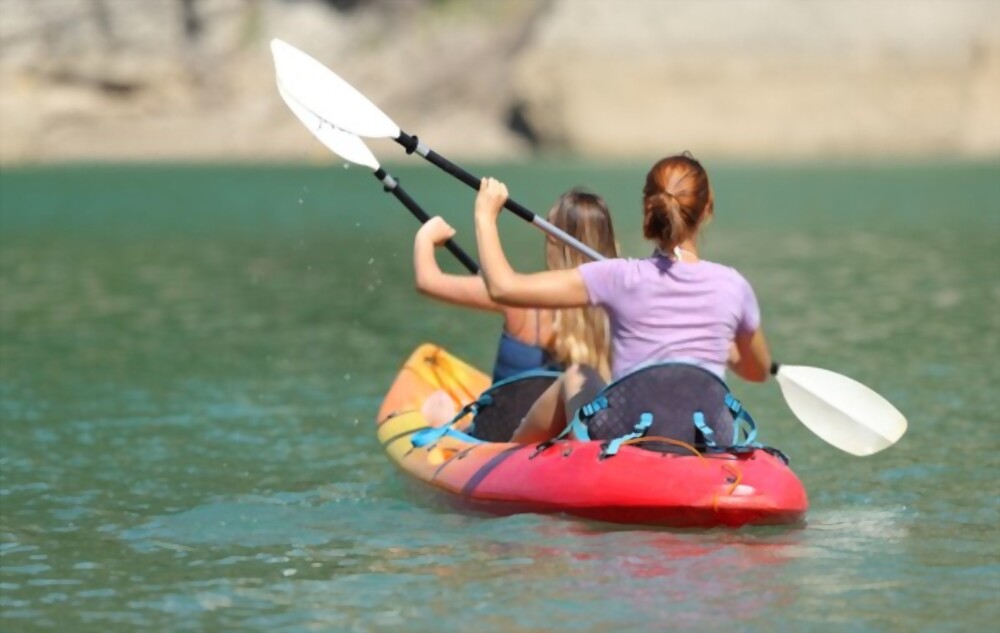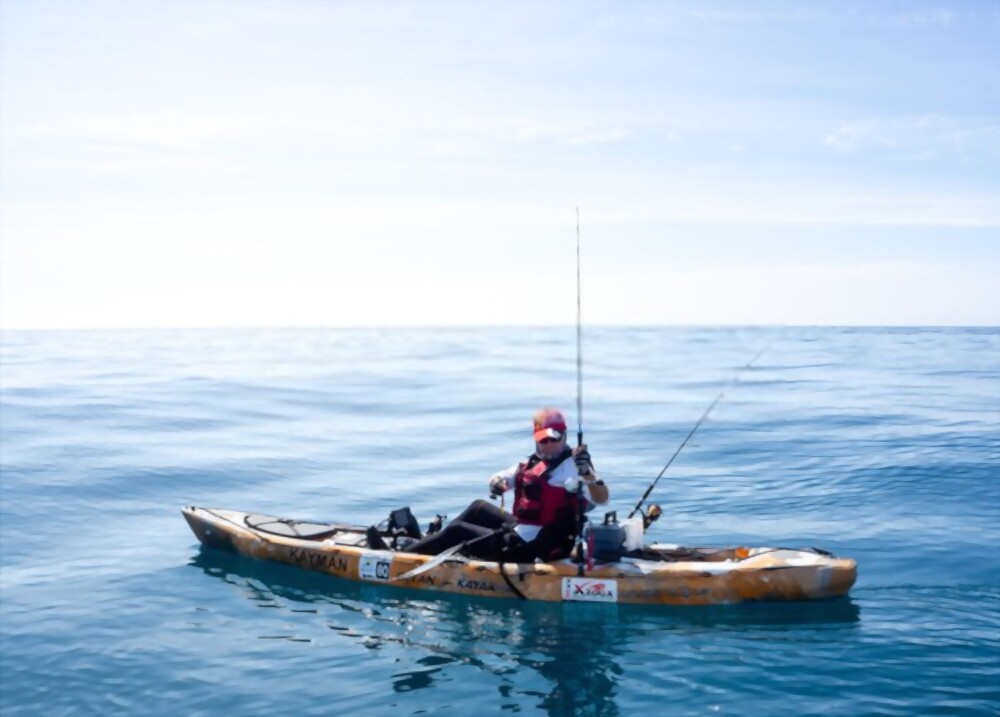Kayak dimensions are important to consider when deciding which kayak to buy. Kayaks come in a variety of sizes and shapes, so it is essential to understand their specifications and compare different models before making a purchase. This article outlines the key dimensions of kayaks, including length, width, depth, weight capacity, and cockpit size. With this knowledge, you can make an informed decision when selecting a kayak.
The average length of a kayak is 10 feet (3.04 meters). However, size can vary greatly depending on the type of kayak and its purpose. There are also many factors that can affect a kayak’s width, volume, and weight.
If you want to gain a deeper understanding of kayaks, keep reading!
Kayak Dimensions According To Types
Kayaks come in a variety of shapes and sizes, each designed for different purposes. Here are some common types of kayaks, along with their dimensions:
Recreational Kayaks

Recreational kayaks are designed for casual use on calm waters such as lakes, rivers, and bays. They typically have a wider and more stable design than other types of kayaks, making them easy to maneuver and handle. A recreational kayak typically has dimensions between 10 and 12 feet long and at least 2 feet wide. This makes it a great choice for those looking for
Sit-on-Top Kayaks

Sit-on-top kayaks are a type of recreational kayak that features an open cockpit design, where the paddler sits on top of the kayak rather than inside of it. This design allows for easy entry and exit, as well as the ability to easily get in and out of the water. Sit-on-top kayaks are typically short and wide boats that measure less than 12 feet (3.66 meters) in length, with a width between 27 and 36 inches (0.69 and 0.91 meters).
Tandem Kayaks

Tandem kayaks, also known as double kayaks, are designed to be paddled by two people. They
come in a variety of sizes, from 10 to 26 feet (3.04 to 7.82 meters) long and 18 to 28 inches (0.46 to 0.71 meters) wide.
They are typically longer and wider than single kayaks and have two seating positions, one in the front and one in the back. Tandem kayaks can be a great option for couples, families, or friends who want to share the experience of kayaking together.
Touring Kayaks

Touring kayaks are designed for longer trips on open water such as lakes, bays, and coastal waters. The lengths and widths of touring kayaks typically range between 12 to 20 feet (3.66 to 6.1 meters) long, and 18 to 24 inches (0.46 to 0.61 meters) wide, respectively.
They typically have a longer and narrower design than recreational kayaks, which allows them to track straighter and faster through the water. They also often have a rudder or skeg, which helps to improve their handling and maneuverability in windy conditions. They are a popular choice for experienced kayakers and those who want to explore more remote or open water areas.
Important Kayak Factors to Consider When Choosing
In addition to length and width, there are other factors to consider when selecting a kayak. These include the weight capacity of the kayak, its depth, and the size of the cockpit.
Weight of Kayak
The weight of a kayak can vary significantly depending on the model. Some may be lightweight and highly portable, while others are designed to withstand rougher waters and may be heavier.
The weight of a kayak depends on its size, length, and volume. On average, they range from 20 to 80 pounds (9.07 to 36.29 kilograms). However, some larger kayaks that have a high volume can weigh more than 100 pounds (45.36 kilograms).
Volume of Kayak
The volume of a kayak is an important factor to consider when shopping for one. It indicates how much space the kayak takes up, which in turn determines how many items it can accommodate and where you can store the kayak.
When looking for a kayak, beginner recreational riders should consider the volume of their kayak. Generally speaking, a higher-volume kayak is best for new riders who do not intend to use it for speed. Furthermore, the rider’s height should also be taken into account when selecting a kayak of a suitable volume.
The volume of a kayak can have an important impact on the amount of legroom and cockpit space available. If you are looking for more room, a higher-volume kayak may be the better option. On the other hand, if you are considering an overnight paddling trip, a low-volume kayak may not provide enough space. It is important to consider the volume of the kayak before making your final decision.
When choosing a kayak, it is important to consider the volume of the boat. This chart will help you pick the size that best suits your personal needs.
Weight Capacity of Kayak
The weight capacity of a kayak refers to the amount of weight it can carry, including the paddler and any additional gear. For recreational kayaks, the weight capacity should be determined by the user’s level of experience and paddling skill. If you are planning a longer kayaking trip, it is important to find a kayak with sufficient storage space.
Legroom of Kayak
Legroom is also an important consideration when selecting a kayak. It will determine how comfortable you feel and whether you can stretch out your legs fully. Kayaks come in a variety of different sizes and legroom varies depending on the model. Generally speaking, longer kayaks offer more legroom. However, the width of the kayak should also be taken into account as it will impact legroom as well.
For sit-in kayaks, a good fit is important in order to maximize comfort and performance. It should be tight enough that there’s contact between the kayak and your body, but not overly so that it is difficult to enter and exit.
Sit-on-top kayaks from Ocean Kayak provide paddlers with a different experience than traditional kayaks, as they feature a molded depression in the top of the boat for the paddler to sit in, instead of being enclosed in a cockpit. This design allows for more maneuverability and flexibility while on the water.
Kayak Cockpit Size
The cockpit of your kayak is where you’ll be sitting, supported by the dimensions of the area around your waist and the space accommodating your legs. It will determine how comfortable you feel and whether you can move freely in the boat. Kayaks come in a variety of different cockpit sizes, from small and narrow to large and wide. The dimensions of the cockpit will be different for each model and brand, so it is important to measure the size before selecting one.
If you have a larger body type, it is recommended to opt for either a fishing kayak or a touring kayak since their cockpits tend to be more spacious and accommodate larger riders.
Related: What Are The Hula Hoop Sizes?
How To Choose a Kayak Size Based on Water Type?
Rivers
A recreational kayak is essential for floating down a river, as it provides stability and maneuverability. This type of kayak allows you to leisurely follow the flow of the river, rather than needing speed. When deciding on a kayak for rivers, it’s important to select the size that best suits your needs. Ideally, you should opt for something between 8 and 13 feet in length.
Lakes
For most lakes, you should be fine in a recreational kayak similar to one for rivers. If you plan to explore larger lakes with bigger waves, it is a good idea to invest in a touring kayak. Fishing kayaks are an excellent choice for those who enjoy fishing in lakes. They allow you to transport your tackle and gear easily and safely, while also providing you with a comfortable and stable platform to cast your line.
Ocean / Sea
Kayaking in the open ocean can present a different set of challenges than kayaking on calmer bodies of water. Stronger winds, higher tides, and larger waves can be present, requiring greater knowledge and experience to paddle safely.
A touring kayak, or sea kayak, is designed to cover longer distances with greater ease. Typically measuring 12 feet in length or more, these kayaks present a greater challenge for beginners compared to recreational kayaks. For those new to the activity, it might be best to start with something more manageable.
What kayak size should I choose based on my weight?
When deciding what size kayak you need for your weight, consider the width, length, and volume of the boat based on your height. For individuals who measure up to 5 feet 5 inches (1.68 meters) and weigh 140 pounds (63.5 kilograms) or less, a low-volume kayak is the best choice. It will provide a comfortable fit and stability while paddling. With its smaller size, it’s also easier to maneuver and transport.
Medium-sized kayaks are ideally suited for individuals who are between 5 feet 7 inches and 5 feet 10 inches in height, with a weight of 150 to 180 pounds.
High-volume kayaks are designed for more serious and experienced riders, as they provide better stability and performance in large bodies of water. They are ideal for multi-day trips and should be chosen by riders who are 5 feet 10 inches tall (1.80 meters) with weight of 180 pounds (68 kilograms) or nearby.
Canoes or kayaks: Which is better?
Kayaks are generally more agile than canoes, which makes them ideal for faster trips. On the other hand, canoes offer increased safety due to their wider design and lower risk of capsizing.
Are overweight people able to kayak?
Yes, you can kayak if you are overweight. Kayaking is a low-impact activity that can be enjoyed by people of all sizes and abilities. It’s important to choose a kayak that can safely support your weight. Be sure to check the weight capacity of the kayak before doing it.
Related: Standard Treadmill Dimensions
Conclusion:
Finding the right kayak size for your body type is important. Although 10 feet (3.04 meters) may be the standard length of a kayak, this size is not necessarily the ideal choice for everyone. Depending on a person’s height and weight, they may need to choose a shorter or longer kayak to ensure they are comfortable and safe while paddling.
It is an enjoyable activity that can be enjoyed by people of all sizes and abilities. When selecting a kayak, it’s important to consider the volume of the boat, as well as its length, width, and weight capacity. Additionally, the user’s level of experience and paddling skill should also be taken into account when selecting a suitable boat.
FAQs
How do I know what size kayak I need?
Your body size, weight, skill level, and intended use will determine what size kayak you need. Here are a few things to consider: a) Weight capacity: You should be able to carry your weight and any additional gear safely. Choosing the right kayak depends on a bunch of things, like your type of water and how fast you want to move.
B) Length:
Longer kayaks track better and are faster, but shorter ones are easier to maneuver.
C) Width: Wider kayaks are better for beginners and people who want to fish or take pictures. For experienced paddlers looking for speed and efficiency, narrower kayaks are better. d) Cockpit size: Make sure the cockpit fits you. e) Type of kayaking: Different kayaking types have different kayak size recommendations, such as recreational, touring, whitewater, or sea kayaking.
Choose a kayak based on its intended use.
What is the standard size of a kayak?
A kayak comes in all sorts of lengths and widths, so there’s no single standard size. Depending on the kayak and its intended use, it can range from around 8 feet to over 18 feet in length. Its width can vary from 22 inches to 36 inches.
What is the difference between kayak sizes?
Longer kayaks tend to have better tracking (the ability to move in a straight line) and a higher speed, making them perfect for touring or long-distance paddling. You can navigate narrow waterways or play in waves better with shorter kayaks because they’re more maneuverable and easier to turn. Beginners or people who do fishing or photography can use wider kayaks because they’re more stable.
Kayaks with narrower hulls sacrifice stability for speed and efficiency, making them perfect for racers or experienced paddlers.
How do I choose a kayak for beginners?
When choosing a kayak for beginners, consider the following factors:
a) Stability: Opt for a kayak with good initial stability, meaning it feels stable when you’re sitting in it. This will help you gain confidence and balance as you learn to paddle.
b) Maneuverability: Look for a kayak that is easy to maneuver, especially if you’ll be paddling in tight spaces or navigating obstacles.
c) Comfort: Choose a kayak with a comfortable seat and adjustable footrests to ensure a pleasant paddling experience.
d) Weight: Consider the weight of the kayak, especially if you’ll be transporting it on your own. Lighter kayaks are easier to handle and carry.
e) Recreational or sit-on-top kayaks: These types of kayaks are often recommended for beginners due to their stability, ease of use, and self-draining capabilities.